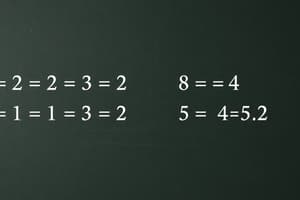Podcast
Questions and Answers
What is the purpose of logical operations in programming languages and instruction set architectures?
What is the purpose of logical operations in programming languages and instruction set architectures?
- To manage memory more efficiently
- To control the flow of execution in programs
- To simplify the packing and unpacking of bits into words (correct)
- To perform calculations with floating-point numbers
How can the NOT operation be implemented according to the content?
How can the NOT operation be implemented according to the content?
- Using XOR with one operand being all ones (correct)
- Using AND with a zero operand
- Using OR with a one operand
- Using shifting operations on the bits
What example is used to illustrate operations on characters within a word?
What example is used to illustrate operations on characters within a word?
- Processing of 16-bit words
- Examining 8-bit characters (correct)
- Manipulating hexadecimal values
- Performing arithmetic operations on bytes
Which of the following languages are shown in the figure for logical operations?
Which of the following languages are shown in the figure for logical operations?
What historical figure is referenced in relation to logical operations?
What historical figure is referenced in relation to logical operations?
What does biased notation achieve in numerical representation?
What does biased notation achieve in numerical representation?
In RISC-V, how are instruction fields typically referred to?
In RISC-V, how are instruction fields typically referred to?
What binary value typically represents zero in biased notation?
What binary value typically represents zero in biased notation?
Which of the following correctly identifies a segment of an instruction in RISC-V?
Which of the following correctly identifies a segment of an instruction in RISC-V?
What is the decimal representation of the register used in the RISC-V instruction 'add x9, x20, x21' for register x21?
What is the decimal representation of the register used in the RISC-V instruction 'add x9, x20, x21' for register x21?
What is the significance of the fields containing 0, 0, and 51 in the instruction 'add x9, x20, x21'?
What is the significance of the fields containing 0, 0, and 51 in the instruction 'add x9, x20, x21'?
What is a likely reason for representing instructions as series of electronic signals?
What is a likely reason for representing instructions as series of electronic signals?
What kind of numerical representation does biased notation utilize for positive values?
What kind of numerical representation does biased notation utilize for positive values?
What is the primary method to find the negative equivalent of a one’s complement representation?
What is the primary method to find the negative equivalent of a one’s complement representation?
Which statement accurately describes one’s complement compared to two’s complement?
Which statement accurately describes one’s complement compared to two’s complement?
Why did one’s complement see use in early scientific computers?
Why did one’s complement see use in early scientific computers?
What is the relationship between the various representations discussed?
What is the relationship between the various representations discussed?
What does the notation 10 … 000two represent in one’s complement?
What does the notation 10 … 000two represent in one’s complement?
How does the negation operation in one’s complement compare to two’s complement?
How does the negation operation in one’s complement compare to two’s complement?
What is the most significant characteristic of biased notation?
What is the most significant characteristic of biased notation?
What is the result of performing a one’s complement negation on a number?
What is the result of performing a one’s complement negation on a number?
What is the purpose of the 12-bit immediate in the I-type instruction format?
What is the purpose of the 12-bit immediate in the I-type instruction format?
What principle of hardware design is highlighted by the RISC-V designers?
What principle of hardware design is highlighted by the RISC-V designers?
Which fields are included in the I-type instruction format?
Which fields are included in the I-type instruction format?
What does the 'lw' instruction signify in the provided example?
What does the 'lw' instruction signify in the provided example?
How many bits are used for the rs1 field in the I-type format?
How many bits are used for the rs1 field in the I-type format?
What limit does the 12-bit immediate in the I-type format impose on its value?
What limit does the 12-bit immediate in the I-type format impose on its value?
What distinguishes the S-type instruction format from the I-type format?
What distinguishes the S-type instruction format from the I-type format?
What is the maximum range of bytes that the I-type load instructions can access?
What is the maximum range of bytes that the I-type load instructions can access?
What is the primary purpose of the immediate field in RISC-V instructions?
What is the primary purpose of the immediate field in RISC-V instructions?
Which of the following instructions is not available in RISC-V?
Which of the following instructions is not available in RISC-V?
In the assembly language, what does the assembler generate when the programmer writes 'add'?
In the assembly language, what does the assembler generate when the programmer writes 'add'?
How does the design principle of smaller instructions affect register usage?
How does the design principle of smaller instructions affect register usage?
Why do RISC-V instructions maintain the same size?
Why do RISC-V instructions maintain the same size?
Which parts of RISC-V machine language are summarized in the provided content?
Which parts of RISC-V machine language are summarized in the provided content?
What is the role of funct3 in RISC-V instructions?
What is the role of funct3 in RISC-V instructions?
What is a limitation imposed on the immediate field due to using two’s complement representation?
What is a limitation imposed on the immediate field due to using two’s complement representation?
Flashcards are hidden until you start studying
Study Notes
Two's and One's Complement Representations
- Two's complement allows representation of signed integers, with the rule that the sum of a number and its two's complement equals (2^n).
- The formula for negation in two's complement: (2^n - x).
- One's complement represents negative values by inverting each bit (0 to 1, 1 to 0).
- One's complement has two representations of zero: positive (00…00) and negative (11…11).
- The most negative value in one's complement represents (-2,147,483,647).
- Both one's and two's complement systems allow an equal number of positive and negative values.
Biased Notation
- Biased notation favors non-negative representations by adjusting numbers with a bias.
- In biased representation, 00…000 is the most negative value, while 11…11 represents the most positive value, 0 typically being 10…00.
Computer Instruction Representation
- Instructions in computers are stored as electronic signals, organized in a sequence of numbers.
- Each part of an instruction is termed a field. In RISC-V, fields are used to define operations and operands.
RISC-V Instruction Formats
- RISC-V instructions are categorized mainly into R-type and I-type.
- R-type is for operations between registers, while I-type includes arithmetic with one constant operand.
- The I-type format features:
- 12-bit immediate (two's complement)
- 5-bit source register (rs1)
- 3-bit function (funct3)
- 5-bit destination register (rd)
- 7-bit opcode
Examples of RISC-V Instructions
- Example:
add x9, x20, x21is represented in decimal as: 0, 21, 20, 0, 9, 51.
- The instruction
lw x9, 32(x22)is broken down into its respective fields:- rs1 = 22, immediate = 32, rd = 9.
Design Principles of RISC-V
- A key design principle states that good design requires good compromises; maintaining equal instruction length leads to distinct formats for different instructions.
- RISC-V prioritizes keeping all instructions uniform, which creates limitations on the number of registers without increasing complexity.
Instruction Types in RISC-V
- S-type format is used for store instructions, which requires both source registers and an immediate value for addressing.
- The S-type format segments the immediate field into upper and lower parts to accommodate addressing needs effectively.
Conclusion
- Logical operations extend the capability of programming languages to handle bits within a word, including packing and unpacking of bits.
- Instructions such as NOT in RISC-V can be implemented using XOR with an operand of all ones.
Studying That Suits You
Use AI to generate personalized quizzes and flashcards to suit your learning preferences.




